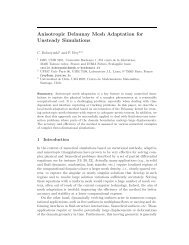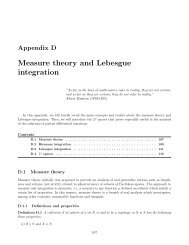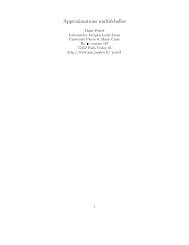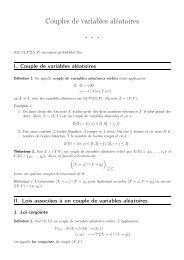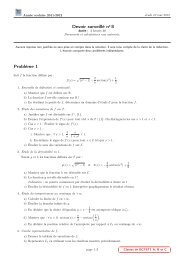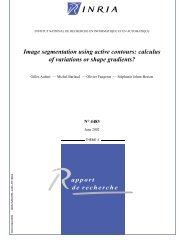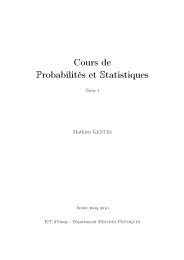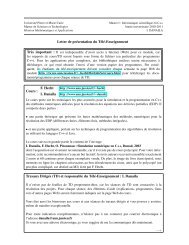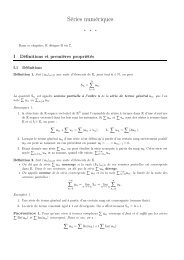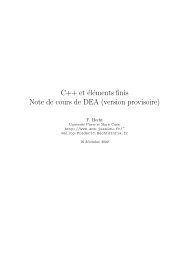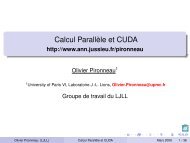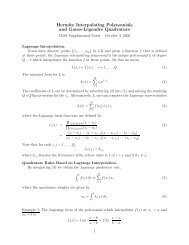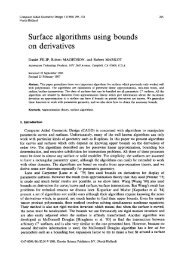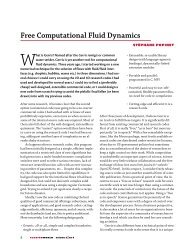pdf file
pdf file
pdf file
Create successful ePaper yourself
Turn your PDF publications into a flip-book with our unique Google optimized e-Paper software.
4 M. LEWIN, P. T. NAM, S. SERFATY, AND J. P. SOLOVEJ<br />
operator NeH+H, up to an error of order o(1). Formally, we therefore find<br />
that<br />
HN ≃ N eH +H+o(1). (3)<br />
This vague statement is made precise in our main result, Theorem 2 below.<br />
The essential fact about the Bogoliubov Hamiltonian H is that it is a non<br />
particle conserving self-adjoint operator acting on the Fock space<br />
F+ := C⊕ � n�<br />
where<br />
n≥1 sym<br />
H+<br />
H+ = {u0} ⊥ ⊂ L 2 (Ω)<br />
is the one-body space of excited particles. We started with a particleconserving<br />
model and we end up with a theory in Fock space, in which<br />
the number of particles is not fixed. The reason is that we are describing<br />
here the excitations around the reference Hartree state.<br />
For the acquainted reader, we mention that H is indeed nothing but the<br />
second-quantization of (half) the Hessian of the Hartree energy at u0, and<br />
its expression in a second quantized form is<br />
�<br />
H :=<br />
Ω<br />
a ∗ (x) � ha � (x)dx+ 1<br />
2<br />
�<br />
Ω<br />
�<br />
Ω<br />
�<br />
w(x−y) 2u0(x)u0(y)a ∗ (x)a(y)<br />
�<br />
dxdy. (4)<br />
+u0(x)u0(y)a ∗ (x)a ∗ (y)+u0(x)u0(y)a(x)a(y)<br />
Here a ∗ (x) is the creation operator of an excited particle at x, acting in the<br />
Fock space F+, and h is defined in (2). We will explain the meaning of this<br />
formula later in Section 2.2.<br />
A result similar to (3) has recently been obtained for weakly interacting<br />
Bose gases by Seiringer [52] and Grech-Seiringer [24]. They assumed that<br />
w is bounded, decays fast enough and has non-negative Fourier transform.<br />
The operator T was T = −∆ in a box with periodic boundary conditions<br />
in [52] and T = −∆+V(x) on R d with V(x) → +∞ at infinity in [24]. Our<br />
method is different from that of [52, 24] and it applies to a larger class of<br />
models.<br />
We give in this paper a list of abstract conditions that a Bose gas should<br />
satisfy in order to get the Bogoliubov result (3). These conditions are given<br />
and explained in Section 2.1 below. Loosely speaking, we assume that there<br />
is complete Bose-Einstein condensation on a unique Hartree minimizer u0<br />
which we assume to be non-degenerate. Our message is that, once the Bose-<br />
Einstein condensation is proved, one can get the next order in the expansion<br />
of the energy by Bogoliubov’s theory. No further assumption is needed.<br />
Thepaperisorganized asfollows. Inthenextsection, wedefineourmodel<br />
by giving the appropriate assumptions on T and w, and we properly define<br />
the Bogoliubov Hamiltonian H. We then state our main results, Theorem 2<br />
and Theorem 3. In Sections 3.1 and 3.2, we apply our abstract result to two<br />
particularexamples: bosonicatomsandtrappedCoulombgases. Sections5–<br />
7 are devoted to the proof of the main abstract results.



